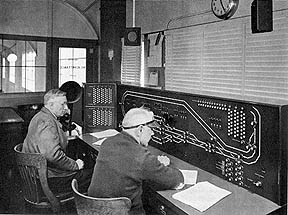
2. Transbay Terminal History
The first two modern facilities which significantly improved mobility and access to San Francisco were the Golden Gate Bridge and the San Francisco-Oakland Bay Bridge (SFOBB). Of the two, the latter clearly had the greatest impact on the growth and development of San Francisco. (Shortly after its opening, passenger crossings of San Francisco Bay doubled.) Early in the planning stages of the SFOBB, however, the Reconstruction Finance Corporation, which was underwriting the bonds, insisted that the success of the bridge would be assured by the incorporation of a commuter rail system.

The Transbay Transit Terminal, a California Toll Bridge Authority facility, originally was constructed in 1939 as a transportation terminal for commuter trains running between San Francisco and the East Bay and utilizing the San Francisco-Oakland Bay Bridge. This terminal is located at First and Mission Streets in San Francisco and has a direct off-street connection to the Bay Bridge. The terminal facility and the rail system crossing the bridge to the East Bay were designed to handle approximately 35 million people annually, with a peak 20-minute rate of 17,000 commuters, utilizing 10-car trains at headways of 63.5 seconds (see Figure 2). Transbay rail operations began in January, 1939, and continued until 1958. At the end of World War 11 (1945), the terminal and rail system were handling approximately 26 million passengers annually. Starting with the elimination of gas rationing in 1945, the patronage declined to an annual rate of four to five million by 1958.
From 1959 to date, the terminal has been utilized by Greyhound Lines and AC Transit to serve commuters from the East Bay. Subsequently, the Gray Line, Continental Trailways, Amtrak, and Golden Gate Transit load and unload passengers at street level under the terminal.
